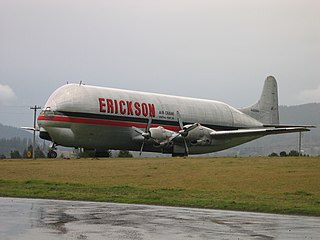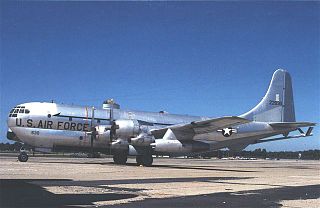
The Airbus A300-600ST, or Beluga, is a specialised wide-body airliner used to transport aircraft parts and outsize cargoes. It received the official name of Super Transporter early on, but its nickname, after the beluga whale, which it resembles, gained popularity and has since been officially adopted.

The Aero Spacelines Super Guppy is a large, wide-bodied cargo aircraft that is used for hauling outsize cargo components. It was the successor to the Pregnant Guppy, the first of the Guppy aircraft produced by Aero Spacelines. Five were built in two variants, both of which were colloquially referred to as the "Super Guppy".

Aero Spacelines Inc. was an American aircraft manufacturer from 1960 to 1968 that converted Boeing 377 Stratocruisers into the famous Guppy line of airplanes, re-engineered to transport oversized cargo such as space exploration vehicles.

The Pratt & Whitney PW4000 is a family of dual-spool, axial-flow, high-bypass turbofan aircraft engines produced by Pratt & Whitney as the successor to the JT9D. It was first run in April 1984, was FAA certified in July 1986, and was introduced in June 1987. With thrust ranging from 50,000 to 99,040 lbf, it is used on many wide-body aircraft.

The Boeing 377 Stratocruiser was a large long-range airliner developed from the C-97 Stratofreighter military transport, itself a derivative of the B-29 Superfortress. The Stratocruiser's first flight was on July 8, 1947. Its design was advanced for its day; its relatively innovative features included two passenger decks and a pressurized cabin. It could carry up to 100 passengers on the main deck plus 14 in the lower deck lounge; typical seating was for 63 or 84 passengers or 28 berthed and five seated passengers.

The Pratt & Whitney PW2000, also known by the military designation F117 and initially referred to as the JT10D, is a series of high-bypass turbofan aircraft engines with a thrust range from 37,000 to 43,000 lbf. Built by Pratt & Whitney, they were designed for the Boeing 757. As a 757 powerplant, these engines compete with the Rolls-Royce RB211.

The Pratt & Whitney R-4360 Wasp Major is an American 28-cylinder four-row radial piston aircraft engine designed and built during World War II. First run in 1944, at 4,362.5 cu in (71.5 L), it is the largest-displacement aviation piston engine to be mass-produced in the United States, and at 4,300 hp (3,200 kW) the most powerful. It was the last of the Pratt & Whitney Wasp family, and the culmination of its maker's piston engine technology.

The Boeing C-97 Stratofreighter was a long-range heavy military cargo aircraft developed from the B-29 and B-50 bombers. Design work began in 1942, the first of three prototype XC-97s flew on 9 November 1944 and the first of six service-test YC-97s flew on 11 March 1947. All nine were based on the 24ST alloy structure and Wright R-3350 engines of the B-29, but with a larger-diameter fuselage upper lobe and they had the B-29 vertical tail with the gunner's position blanked off. The first of three heavily revised YC-97A incorporating the re-engineered wing, taller vertical tail and larger Pratt & Whitney R-4360 engines of the B-50 bomber, flew on 28 January 1948 and was the basis of the subsequent sole YC-97B, all production C-97s, KC-97s and civilian Stratocruiser aircraft. Between 1944 and 1958, 888 C-97s in several versions were built, 811 being KC-97 tankers. C-97s served in the Berlin Airlift, the Korean War, and the Vietnam War. Some aircraft served as flying command posts for the Strategic Air Command, while others were modified for use in Aerospace Rescue and Recovery Squadrons (ARRS).

The General Electric CF6, US military designations F103 and F138, is a family of high-bypass turbofan engines produced by GE Aviation. Based on the TF39, the first high-power high-bypass jet engine, the CF6 powers a wide variety of civilian airliners. The basic engine core also powers the LM2500 and LM6000 marine and power generation turboshafts. It is gradually being replaced by the newer GEnx family.

The Aero Spacelines Pregnant Guppy was a large, wide-bodied cargo aircraft built in the United States and used for ferrying outsized cargo items, most notably components of NASA's Apollo program. The Pregnant Guppy was the first of the Guppy line of aircraft produced by Aero Spacelines. The design inspired later designs, such as the jet-powered Airbus Beluga and Boeing Dreamlifter.

The Boeing KC-97 Stratofreighter is a four-engined, piston-powered United States strategic tanker aircraft based on the Boeing C-97 Stratofreighter. It replaced the KB-29 and was succeeded by the Boeing KC-135 Stratotanker.

The Boeing Dreamlifter, officially the 747-400 Large Cargo Freighter (LCF), is a wide-body cargo aircraft modified extensively from the Boeing 747-400 airliner. With a volume of 65,000 cubic feet (1,840 m3) it can hold three times that of a 747-400F freighter. The outsized aircraft was designed to transport Boeing 787 Dreamliner parts between Italy, Japan, and the U.S., but has also flown medical supplies during the COVID-19 pandemic.

Pan American World Airways Flight 202 was a Boeing 377 Stratocruiser aircraft that crashed in the Amazon Basin about 281 nautical miles southwest of Carolina, Brazil on April 29, 1952. The accident happened en route from Rio de Janeiro, Brazil, to Port of Spain, Trinidad and Tobago, during the third leg of a four-leg journey. All 50 people on board were killed in the deadliest-ever accident involving the Boeing 377.

On Mark Engineering was an American aircraft remanufacturing company established in 1954 at Van Nuys Airport in California. Its most significant products were rebuilding military surplus A-26 Invaders into executive transports—the Marketeer with an unpressurized fuselage and the Marksman with fuselage pressurization. On Mark converted a single B-26 into the YB-26K Prototype. After successful tests, that prototype was reconfigured with 39 other planes into the B-26K Counter-Invaders for counterinsurgency missions with the US Air Force. A total of 40 of the planes were produced. On Mark also undertook conversion work of a Boeing 377 Stratocruiser into the prototype Pregnant Guppy for Aero Spacelines.

The Pratt & Whitney T34 was an American axial flow turboprop engine designed and built by Pratt & Whitney. Its only major application was on the Douglas C-133 Cargomaster.

John Michael Conroy was an American aviator and later businessman, whose company Aero Spacelines developed the Pregnant Guppy, Super Guppy, and Mini Guppy cargo aircraft. He later founded Conroy Aircraft and Specialized Aircraft in Santa Barbara, California.

Outsize cargo is a designation given to goods of unusually large size. This term is often applied to cargo which cannot fit on standardized transport devices such as skids (pallets) or containers. This includes military and other vehicles.

On February 20, 2021, United Airlines Flight 328 (UA328/UAL328), a scheduled U.S. domestic passenger flight from Denver to Honolulu, suffered what was technically ruled a contained engine failure despite shedding large pieces of debris, approximately four minutes after takeoff from Denver International Airport (DEN). Parts departing from the engine cowling of the Boeing 777-222 aircraft resulted in a debris field at least 1 mile (1.6 km) long over suburban residential areas of Broomfield, Colorado. Falling debris was recorded by eyewitnesses using smartphone cameras and a dash cam. Debris fell through the roof of a private home and significantly damaged a parked vehicle.

Transair Flight 810 was a Boeing 737-200 converted freighter aircraft, owned and operated by Rhoades Aviation under the Transair trade name, on a short cargo flight en route from Honolulu International Airport to Kahului Airport on the neighboring Hawaiian island of Maui. Immediately after an early morning takeoff on July 2, 2021, one of its two Pratt & Whitney JT8D turbofan engines faltered, and the first officer, who was flying the aircraft, reduced power to both. The two pilots—who were the only aircraft occupants—began executing the Engine Failure or Shutdown checklist, but became preoccupied with talking to air traffic control (ATC) and performing other flying tasks, and never reached the section of the checklist where the failing engine was to be positively identified and shut down. The captain assumed control but misidentified the failing engine, increased power to that engine, and did not increase power to the other, properly functioning engine. Convinced that neither engine was working properly and unable to maintain altitude with one engine faltering and the other idling, the pilots ditched off the coast of Oahu about 11 minutes into the flight.





















